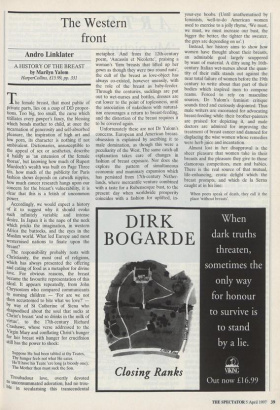The Western front
Andro Linklater
A HISTORY OF THE BREAST by Marilyn Yalom HarperCollins, £15.99, pp. 331 The female breast, that most public of private parts, lies on a cusp of DD propor- tions. Too big, too small, the curse which titillates every gawper's fancy, the blessing which bonds mother to child, at once the incarnation of generosity and self-absorbed pleasure, the inspiration of high art and low porn, its character is nothing if not ambivalent. Dictionaries, unsusceptible to the appeal of sex or aesthetics, describe it baldly as 'an extension of the female thorax', but knowing how much of Rupert Murdoch's wealth was built on Page Three tits, how much of the publicity for Paris fashion shows depends on catwalk nipples, how much cancer research hangs upon our concern for the breast's vulnerability, it is Clear that this is a fetish of uncommon power.
Accordingly, we would expect a history of it to suggest why it should evoke such infinitely variable and intense desire. In Japan it is the nape of the neck which pricks the imagination, in western Africa the buttocks, and the eyes in the Muslim world. What led Europe and most westernised nations to fixate upon the breast?
The responsibility probably rests with Christianity, the most oral of religions, which has always presented the offering and eating of food as a metaphor for divine love. For obvious reasons, the breast became the favourite representation of this ideal. It appears repeatedly, from John Chrysostom who compared communicants to nursing children — 'For are we not then accustomed to bite what we love?' by way of St Catherine of Siena who rhapsodised about the soul that sucks at Christ's breast 'and so drinks in the milk of virtue', to the 17th-century Richard Crashawe, whose verse addressed to the Virgin Mary and conflating Christ's hunger for her breast with hunger for crucifixion still has the power to shock:
Suppose He had been tabled at thy Teates, Thy hunger feels not what He eates. He'll have his Teate 'ere long (a bloody one); The Mother then must suck the Son.
Troubadour love, overtly devoted to unconsummated adoration, had no trou- ble in secularising this transcendental metaphor. And from the 12th-century poem, `Aucassin et Nicolette', praising a woman's 'firm breasts that lifted up her gown as though they were two round nuts', the cult of the breast as love-object has always co-existed, however uneasily, with the role of the breast as baby-feeder. Through the centuries, sucklings are put out to wet-nurses and bottles, dresses are cut lower to the point of toplessness, until the association of nakedness with natural- ism encourages a return to breast-feeding, and the distortion of the breast requires it to be covered again. Unfortunately these are not Dr Yalom's concerns. European and American breast- obsession is explained by ascribing it to male domination, as though this were a peculiarity of the West. The same catch-all explanation takes care of changes in fashion of breast exposure. Nor does she explore the pattern of simultaneous economic and mammary expansion which has persisted from 17th-century Nether- lands, where mercantile venture combined with a taste for a Rubensesque bust, to the present day when worldwide prosperity coincides with a fashion for uplifted, in- your-eye boobs. (Until anathematised by feminists, well-to-do American women used to exercise to a jolly rhyme, 'We must, we must, we must increase our bust, the bigger the better, the tighter the sweater, the guys are depending on us'.) Instead, her history aims to show how women have thought about their breasts, an admirable goal largely scuppered by want of material. A ditty sung by 16th- century Italian wet-nurses about the quan- tity of their milk stands out against the near total failure of women before the 19th century to write about that part of their bodies which inspired men to compose reams. Forced to rely on masculine sources, Dr Yalom's feminist critique sounds tired and curiously disjointed. Thus male writers are excoriated for advocating breast-feeding while their brother-painters are praised for depicting it, and male doctors are admired for improving the treatment of breast cancer and damned for displacing the wise women whose remedies were herb juice and incantation.
Almost lost in her disapproval is the sheer pleasure that women take in their breasts and the pleasure they give to those clamorous competitors, men and babies. There is the real source of that mutual, life-enhancing, erotic delight which the breast prompts, and which de la Sema caught at in his line:
When poets speak of death, they call it the place 'without breasts'.


























































 Previous page
Previous page